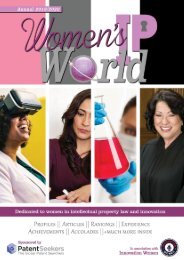Global IP Matrix - Issue 5
It has been a fantastic year for The Global IP Matrix magazine, thanks to all the efforts made by our contributors and to you, the reader for your continued support. We take great pleasure in putting together each issue of this publication, and we sincerely hope you enjoy this final issue of 2019. We have again, collaborated with some of the world's most influential IP law firms and businesses to bring you another eclectic mix of content, direct from the professionals working at ground level. We are already excited for the coming year and cannot wait to continue growing and evolving in our partnerships to bring you some exciting new features for 2020. Ms. Elvin Hassan Editor & Head of international liaisons
It has been a fantastic year for The Global IP Matrix magazine, thanks to all the efforts made by our contributors and to you, the reader for your continued support. We take great pleasure in putting together each issue of this publication, and we sincerely hope you enjoy this final issue of 2019. We have again, collaborated with some of the world's most influential IP law firms and businesses to bring you another eclectic mix of content, direct from the professionals working at ground level. We are already excited for the coming year and cannot wait to continue growing and evolving in our partnerships to bring you some exciting new features for 2020.
Ms. Elvin Hassan
Editor & Head of international liaisons
Create successful ePaper yourself
Turn your PDF publications into a flip-book with our unique Google optimized e-Paper software.
Examples of well-known Geographical<br />
Indications include “Darjeeling Tea,” “Persian<br />
Rugs,” “Swiss Watches,” “Champagne” and<br />
from Nigeria, (though no provision has been<br />
made for the registration of GI), one can<br />
think of “Ofada Rice” and “Dongoyaro Tea.”<br />
While most often used in food products,<br />
Geographical Indications can be used to<br />
identify unconsumable products that may be<br />
associated with a specific geographic location.<br />
4<br />
is made in Article 1 (2) and Article 10 of the<br />
Paris Convention, where the latter Article<br />
in dealing with false indications of goods,<br />
states that the provisions dealing with goods<br />
unlawfully bearing a trademark and their<br />
seizure:<br />
“…shall apply in cases of direct or indirect use<br />
of a false indication of source of the goods or<br />
the identity of the producer, manufacturer, or<br />
merchant.”<br />
Any producer, manufacturer, or merchant,<br />
whether a natural person or a legal entity,<br />
engaged in the production or manufacture of/<br />
or trade in such goods and established either in<br />
the locality falsely indicated as the source, or in<br />
the region where such locality is situated, or in<br />
the country falsely indicated, or in the country<br />
where the false indication of source is used,<br />
shall in any case be deemed an interested party.<br />
as climate, soil, or traditional methods of<br />
production, etc. 8<br />
The term “appellation of origin” is mentioned<br />
in Article 1(2) of the Paris Convention and is<br />
defined in Article 2 of the Lisbon Agreement<br />
thus:<br />
“Appellations of origin means the geographical<br />
name of a country, region or locality, which<br />
serves to designate a product originating<br />
therein, the quality and characteristics of<br />
which are due exclusively or essentially to the<br />
geographical environment, including natural<br />
and human factors. The country of origin is the<br />
country whose name or the country in which<br />
is situated the region or locality whose name<br />
constitutes the appellation of origin which has<br />
given the product its reputation”.<br />
Three elements are identifiable in the above<br />
definition: 9<br />
The use of Geographical Indications allows<br />
producers to obtain market recognition<br />
and often a premium price. With the<br />
increased internationalisation of food and<br />
product markets, Geographical Indications<br />
have become a vital source of marketing.<br />
Geographical Indications are also often<br />
associated with non-monetary benefits such as<br />
the protection of knowledge and community<br />
rights. 5<br />
In order to fully understand the meaning of<br />
Geographical Indications and how the term is<br />
derived, there are at least two other important<br />
concepts linked to the idea of Geographical<br />
Indications that must be analysed, these<br />
being; “indication of source” and “appellation<br />
of origin.”<br />
Long before a multilateral agreement was<br />
reached on the definition of Geographical<br />
Indications, and how they are to be protected,<br />
i.e., TR<strong>IP</strong>S Agreement; the concepts of<br />
“indication of source” and “appellation<br />
of origin” were incorporated in other<br />
international treaties. These are: the Paris<br />
Convention for the Protection of Industrial<br />
Property of 1883 (Paris Convention), the<br />
Madrid Agreement for the Repression of False<br />
or Deceptive Indications of Source on Goods<br />
of 1891 (Madrid Agreement), and the Lisbon<br />
Agreement for the Protection of Appellations<br />
of Origin and their International registration<br />
of 1958 (Lisbon Agreement). 6<br />
i. INDICATION<br />
OF SOURCE<br />
Indication of sources refers<br />
to a sign that indicates that a<br />
product originates in a specific<br />
geographical region.6 An example<br />
being, Ofada Rice, which refers<br />
only to geographic origin. It is the<br />
broadest concept when compared<br />
to Geographical Indications and<br />
appellations of origin and appears<br />
in both the Paris Convention and<br />
the Madrid Agreement. Neither<br />
agreement, however, defines<br />
indication of source. Reference<br />
Further clarification of the notion of<br />
“indication of source” is found in Article 1(1) of<br />
the Madrid Agreement:<br />
“All goods bearing a false or deceptive<br />
indication by which one of the countries to<br />
which this Agreement applies, or a place<br />
situated therein, is directly or indirectly<br />
indicated as being the country or place of origin<br />
shall be seized on importation into any of the<br />
said countries.”<br />
Article 1(2) of the Paris Convention defines<br />
objects for the protection of industrial<br />
property and refers to both “indication of<br />
source” and “appellation of origin,” which<br />
may suggest that both expressions could be<br />
synonymous. There are, however, distinct<br />
differences between the two.<br />
ii. APPELLATION OF<br />
ORIGIN<br />
This refers to a sign that indicates that a<br />
product originates in a specific geographical<br />
region only when the characteristic qualities<br />
of the product are due to the geographical<br />
environment, including natural and human<br />
factors. 7<br />
Unlike an indication of source, which is only<br />
subject to the condition that a given product<br />
originates in the place designated by the<br />
indication of source, the use of appellation<br />
of origin requires a quality linkage between<br />
the product and its geographical origin. This<br />
means that certain characteristics of the<br />
product should be essentially or exclusively<br />
attributable to its geographic origin, such<br />
22 www.gipmatrix.com<br />
a. The appellation must be a direct<br />
geographical name (not symbols or other<br />
kinds of expression) of the country, the<br />
region or the locality.<br />
b. The appellation must serve as a<br />
designation of the geographical origin<br />
for the product, which means that the<br />
product and geographical name must be<br />
the same, such as Porto or Bordeaux;<br />
c. The quality and characteristics exhibited<br />
by the product must be essentially/<br />
exclusively attributable to the designated<br />
area of geographical origin.<br />
Relative to the Madrid Agreement, these<br />
conditions for qualifying appellations are<br />
higher, thus narrowing the range of possible<br />
indications. An example of protected<br />
appellations under the Lisbon Agreement<br />
includes ‘Bordeaux’ for wine.<br />
The African Landscape<br />
Geographical Indications, taken as any<br />
geographical name or sign affixed to a good<br />
which conveys geographical information that<br />
is useful in identifying the origin, reputation<br />
and qualities of the product can be legally<br />
protected in two primary forms in Africa.<br />
Defensive protection, which focuses on the<br />
prevention of misleading indications and<br />
unfair competition and positive protection<br />
involving the registration of a Geographical<br />
Indication either through a sui generis<br />
system or as trademarks. The legal means for<br />
obtaining defensive protection would mainly<br />
be through unfair competition laws, common<br />
law rules on passing off or case<br />
law.<br />
There exists the possibility of<br />
obtaining positive Geographical<br />
Indication protection, in one form<br />
or another, in all but six African<br />
countries. 10<br />
For these six countries, there is<br />
no positive protection available,<br />
or there is no reliable information<br />
on whether positive Geographical<br />
Indication protection can<br />
be obtained. Among the 47<br />
countries where there is some<br />
level of positive protection, such<br />
protection can be obtained under












